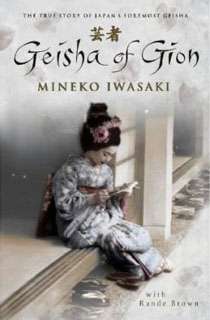Mineko Iwasaki

Mineko Iwasaki (岩崎 峰子 Iwasaki Mineko) also known as Mineko Iwasaki (岩崎 究香 Iwasaki Mineko), born Masako Tanaka (田中 政子 Tanaka Masako, born 2 November 1949), is a Japanese businesswoman, author and former geiko (Kyoto term for geisha). Iwasaki was the most famous geiko in Japan until her sudden publicized retirement at the age of 29. Known for her performances for celebrity and royalty during her geisha life, Iwasaki was an established heir or atotori to her geisha house (okiya) while she was just an apprentice.
American author Arthur Golden interviewed her for background information when writing his 1997 book, Memoirs of a Geisha.[1] Iwasaki later regretted interviewing for Golden, having cited a breach of confidentiality and later sued and settled out of court with Golden for the parallelism between his book and her life. She later released her own autobiography titled Geisha of Gion (UK) or Geisha: A Life (USA) in 2002.
Overview
Born as Masako Tanaka, she left home at the age of five to begin studying traditional Japanese dance at the Iwasaki okiya (geisha house) in the Gion district of Kyoto. She was legally adopted by the okiya's owner, Madame Oima, and began using their family name of Iwasaki. She had been chosen as the house's atotori, or heir. Iwasaki became a maiko (apprentice geiko) at age 15. She also received the name Mineko, as prescribed by a Japanese fortune-teller. By age 16, she had earned a reputation as Japan's most popular maiko and finally became a geiko on her 21st birthday.
According to her autobiography, Iwasaki worked herself to her physical and mental limits. She developed a near-fatal kidney condition but recovered and made a strong re-entry into the geiko community. She entertained numerous celebrities and foreign dignitaries including United Kingdom's Queen Elizabeth II and Prince Charles. Iwasaki's fame also made her the subject of jealousy and gossip, and she was sometimes faced with physical harassment when performing and in public. In her autobiography, she describes having to defend herself with a sharp piece of bamboo from a basket she was carrying when a group of men assaulted her on the street.
After the death of one of her most significant mentors in 1980, Iwasaki became increasingly frustrated with the tradition-bound world of the geiko, especially inadequacies in the education system. Iwasaki unexpectedly retired at the height of her career, at the age of 29. She hoped that her decision would shock Gion into reform; however, even after over 70 other high ranking geiko emulated her retirement, nothing was changed. In her autobiography, Iwasaki speculates that she may have inadvertently doomed the profession. She transitioned to a career in art after she married an artist named Jin'ichirō Satō in 1982. Their only child, Kosuke, was born in 1983.[2]
Memoirs of a Geisha
Iwasaki was one of several geisha author Arthur Golden interviewed while researching his novel Memoirs of a Geisha. According to Iwasaki, she agreed to speak with Golden on the condition that her involvement would be kept confidential, but Golden revealed her identity by mentioning her name in the book's acknowledgments[3] as well as several national interviews. After Memoirs was published, Iwasaki received criticism and even death threats for violating the traditional geisha code of silence.
Iwasaki felt betrayed by Golden's use of information she considered confidential, as well as the way he twisted reality. She denounced Memoirs of a Geisha as being an inaccurate depiction of the life of a geisha. Iwasaki was particularly offended by the novel's portrayal of geiko engaging in ritualized prostitution. For example, in the novel the main character Sayuri's virginity (called mizuage in the novel) is auctioned off to the highest bidder.[4] Iwasaki stated that, not only did this never happen to her, but that no such custom ever existed in Gion.
Part of Iwasaki's displeasure with Memoirs may have been because the character Sayuri seems obviously modeled on Iwasaki, with many of the book's main characters and events having parallels in Iwasaki's life. These people and experiences are often portrayed negatively in Memoirs, even when their real-life counterparts were positive for Iwasaki.
Iwasaki later gave public interviews citing that many established geiko criticized her interview with Arthur Golden, causing a rupture with the geisha tradition of secrecy to the outside world. Furthermore, Iwasaki has mentioned that she had lost some friends and relationships due to the scandal of her being known due to the book, along with certain inconsistencies and fallacies about Gion which were mentioned in Memoirs of a Geisha.
Iwasaki sued Golden for breach of contract and defamation of character in 2001,[5] which was settled out of court in 2003.[6]
Geisha of Gion
After the publication of Memoirs of a Geisha, Iwasaki decided to write an autobiography, contrasting with the fiction of Golden's book.[7] Her book, co-authored by Rande Gail Brown and published as Geisha: A Life in the US and Geisha of Gion in the UK, detailed her experiences before, during and after her time as a geiko to the outside world. It became a worldwide bestseller.
References
- ↑ Parry, Richard Lloyd (2006-03-30). "The Queen and the Geisha". Times Online. Archived from the original on November 16, 2006. Retrieved 2008-01-14.
- ↑ "Conflicting Memories". People. May 21, 2001.
- ↑ Sims, Calvin (2001-06-19). "A Geisha, a Successful Novel and a Lawsuit". New York Times. Retrieved 2008-01-14.
- ↑ Weider, Tamara (2002-10-10). "News and Features / Remaking a Memoir". The Phoenix. Retrieved 2008-01-14.
- ↑ Italie, Hillel (2001-05-04). "Lawsuit of a Geisha". Asian Week. Retrieved 2008-01-14.
- ↑ "Tokyo Premiere of 'Memoirs of a Geisha' Nets Mixed Reaction, Criticism". CBC News. 2005-11-29. Retrieved 2008-01-14.
- ↑ Kolsky, Alyssa (2002-10-25). "Real Geisha, Real Story". Time Magazine. Retrieved 2008-01-14.
